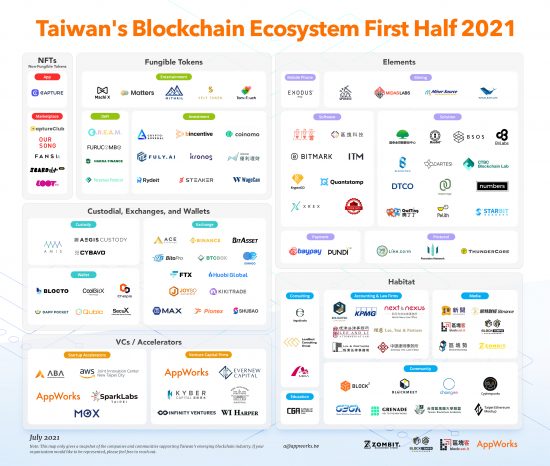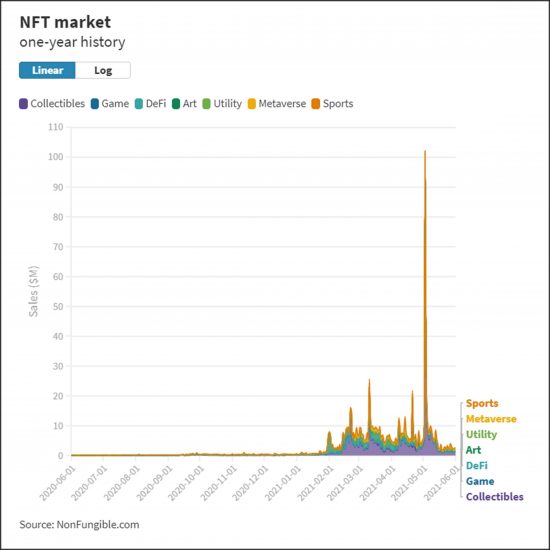
Jack An, Analyst (安良方 / 分析師)
Jack is an Analyst covering AppWorks Accelerator. Before joining the team, he was a co-founder and early team member at two InsurTech startups, where he developed a passion in user experience and product development. Previous to his startup journey he worked as a commercial property underwriter at Chubb Insurance in New Zealand. Jack graduated with a Bachelor of Music from Waikato University where he studied classical piano. He loves to cook, read and is a practicing stoic.
During the first half of 2021, public interest in blockchain reached an all-time high. Towards the end of last year, we saw an upswing in the number of organizations and enterprises buying and holding cryptocurrencies, causing the price of Bitcoin to cross US$60,000 for the very first time in March. Talk of crypto quickly made its way into dinner table conversations, and it seemed as if everybody on the block was eager to dive into the world of blockchain.
For those that have been in crypto for a while, this bull run finally let them exit many of their alt-coin investments from the 2017 ICO wave, as the wider market price sentiment rallied alongside the mainstream coins to reach an all time high. The other worthwhile trend over the past six months has been the mainstream adoption of NFTs (non-fungible tokens), a technology that provides true ownership capabilities and authenticity over digital assets. We saw hoards of multinational brands, intellectual property owners, celebrities, and individual creators quickly embrace this new technology and flock to various platforms to either buy NFTs or mint some of their own.
It’s certainly been an exciting ride since AppWorks Accelerator started publishing Taiwan’s Blockchain Ecosystem Map two years ago. In line with previous editions, we’ve observed several notable trends that have defined the blockchain industry this past half year.
1. Branded drops accelerated end-user adoption of NFTs
The NFT standard was formulated in 2017, so why did it only catch on this past year? It really came down to two key driving forces. First, mainstream brands and IPs started employing NFTs as a vehicle to interact with their fans, such as the NBA through NBA Topshot, Taco Bell, and even the band Kings of Leon. By creating a virtual experience through NFTs, brands were able to engage and create a unique bond with their loyal fans despite physical restrictions under COVID-19, allowing them to also generate alternative revenue streams from the sales of NFTs.
Second, NFTs are becoming an alternative asset class for yield-driven crypto holders and investors. During the ICO era in 2017, most developers and investors were either busy issuing coins or trying to find the next cryptocurrency with hundred-fold growth potential; it wasn’t long until this model became monotonous and out of fashion. Fast forward to 2021, decentralized finance (DeFi) hit a US$100B market cap and drove crypto prices to all-time highs. As NFTs started emerging, crypto holders were naturally drawn to their consumer appeal and accretive potential, propelling NFTs into the limelight for mass adoption. Much of this adoption is supported by advancements in the underlying infrastructure, including a growing ecosystem of protocols, marketplaces, games, developers, creators, and of course, buyers.
Evidently, a lot of moving parts have come together in the last few years to catapult NFTs into stardom. In Taiwan, the NFT landscape has also evolved significantly compared to the second half of 2020. For example, Lootex, an alumnus of AW#20, and Oursong, a subsidiary of KKBox, both established NFT products long before the recent bull run. All the effort they put in during previous cycles are now bearing fruit, with both companies receiving an influx of new partnerships and commercial opportunities. During this time, we also saw a proliferation of new NFT players, such as JCard and Fansi, effectively creating a diverse selection of platforms for creators to choose from.

With Beeple’s First 5000 Days selling for US$69 million, celebrity engagement, and primetime media including even SNL releasing NFT coverage, all the major signs of a bubble were there. And surely enough, monthly transaction volume experienced a significant decline of 90% shortly after its record high in May. Nevertheless, as witnessed with previous blockchain hype cycles, where there is money, there will be talent, and where there is talent, there will be development. Ultimately, NFTs are still in the early innings, and while collectibles have served as the primary use case so far, this new technology will eventually extend across any product, service, or application that needs to use a digital ID.
2. Taiwan’s regulation catching up to the world
Up to recently in Taiwan, the laws and regulations related to cryptocurrency have been very vague. And for those trying to stay compliant, they could only follow the existing but outdated mandate, or hope for the best by following foreign regulations. This was changed in April this year, as the Executive Yuan aligned their stance with the rest of the world by implementing strict AML/KYC requirements when dealing with cryptocurrencies.
Existing players like MaiCoin—the primary fiat-to-crypto exchange in Taiwan—faced minimal impact as stern KYC controls were already in place. However, teams working on DeFi, lending, and investing may face greater obstacles, as it is challenging to design a user experience in a decentralized manner that complies with regulations while still adhering to the spirit of decentralization—a faux pas that many blockchain founders and evangelists are becoming increasingly critical of. Going forward, we expect decision makers to implement more comprehensive and tailored regulations for DeFi to prevent bad actors from gaming the system and taking advantage of everyday consumers; this will ultimately encourage more users and wider adoption, benefitting the ecosystem as a whole.
3. Influx of funding and talent set to accelerate development
With the price of bitcoin hitting an all-time high in H1 2021, investors around the world are taking note of the industry’s activities. For example, in May this year, DApp Pocket (AW#19) announced that they had been acquired by Turn Capital, a family office run by 17LIVE co-founder Joseph Phua. It also merged its two products, DApp Pocket & Cappuu, into Coinomo, with the aim of bringing crypto to mainstream users in Southeast Asia.
At the same time, another blockchain wallet developer in Taiwan Portto (AW#19, AppWorks is an investor), whose product Blocto serves as one of the earliest wallets supporting Flow and the largest delegated node by user count to stake Flow tokens, recently announced the completion of a US$8.8 million fundraising round. Primary investors include top blockchain VCs from Silicon Valley and Taiwan, as well as participation from a notable crypto exchange, public chain foundations, NBA players, and well-known American entrepreneurs, among others.
Despite a significant price correction in cryptocurrencies since May, the momentum that has been brewing over the past six months will likely pay off in the second half of the year, whether through DeFi, NFT, or blockchain applications at both the consumer and enterprise level. We’ve also started to observe more international companies such as Animoca Brands (AppWorks is an investor) enter Taiwan to recruit top-tier blockchain talent, which is expected to further accelerate the development of the country’s blockchain ecosystem.
Taiwan’s Blockchain Ecosystem Map First Half 2021 is created by AppWorks, Co-produced by Blockchain Media – Blockcast (AW#14), BlockTempo (AW#16), Zombit (AW#21). This map is updated every six months, if you have any comments or suggestions don’t hesitate to contact us at [email protected].
【If you are a founder working on a startup in SEA, or working with AI, Blockchain, and NFT, apply to AppWorks Accelerator to join the largest founder community in Greater Southeast Asia.】